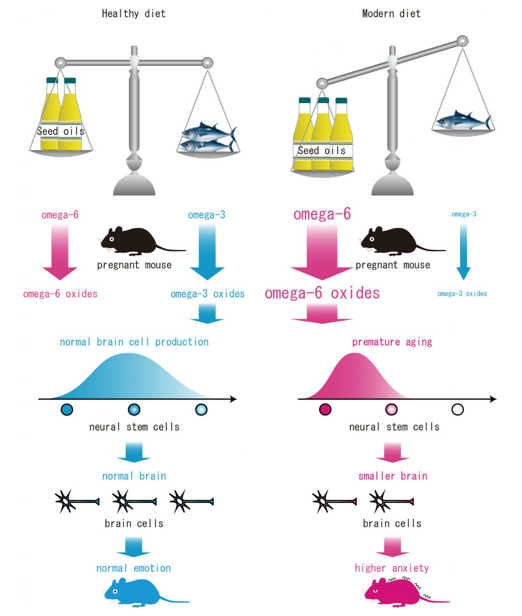| Eat fish in pregnancy to improve baby's brain
Researchers at Tohoku University's School of Medicine have found why eating fish during pregnancy correlates with the health of the baby's brain.
Dietary lipids contain fatty acids such as omega-6 and omega-3, essential nutrients for many animals and humans.
Professor Noriko Osumi's research group, found that a balanced intake of lipids by pregnant women is needed for normal brain formation in the developing child. Their research results are published in Stem Cells.
In animal studies, researchers noticed female mice fed omega-6-rich/omega-3-poor diets, had offspring born with smaller brains and abnormal emotional behavior in adulthood.
This is significant because people in many countries have similarly poor dietary patterns, consuming more seed oils rich in omega-6 fatty acids and less fish rich in omega-3 fatty acids.
According to Professor Osumi, brain abnormalities found in the offsprings of mice used in the study, were caused by premature aging of fetal neural stem cells that go on to produce infant brain cells.
Premature aging of neural stem cells was promoted by an imbalance of oxides in omega-6 and omega-3 fatty acids.
Offspring of mice also reflected higher anxiety levels, even when later raised on nutritionally optimized diets following lactation feeding.
A diet that contains a good balance of omega-6 and omega-3 fatty acids is known to improve developmental brain function. This is based on earlier research evaluating the effects of a mother's omega-3-poor diet on brain function in her children.
This new study took that premise further by focusing on effects of dietary lipids on mouse brain formation. The results reveal omega-6 and omega-3 balance is important for future brain function as a lack of omega-3 fatty acids impairs neocortical neurogenesis in a fetus.
Osumi's research reinforces earlier suggestions that more fish eaten by women in pregnancy benefits her child's health.

For everyday foods high in omega 6, please visit: Top Ten Foods Highest in Omega 6 Fatty Acids
Abstract
Omega-6 (n-6) and omega-3 (n-3) polyunsaturated fatty acids (PUFAs) are essential nutrients. Although several studies have suggested that a balanced dietary n-6:n-3 ratio is essential for brain development, the underlying cellular and molecular mechanism is poorly understood. Here, we found that feeding pregnant mice an n-6 excess/n-3 deficient diet, which reflects modern human diets, impairs neocortical neurogenesis in the offspring. This impaired neurodevelopment occurs through a precocious fate transition of neural stem cells from the neurogenic to gliogenic lineage. A comprehensive mediator lipidomics screen revealed key mediators, epoxy metabolites, which were confirmed functionally using a neurosphere assay. Importantly, although the offspring were raised on a well-balanced n-6:n-3 diet, they exhibited increased anxiety-related behavior in adulthood. These findings provide compelling evidence that excess maternal consumption of n-6 PUFAs combined with insufficient intake of n-3 PUFAs causes abnormal brain development that can have long-lasting effects on the offspring's mental state. Stem Cells 2015; 00:000—000
Publication Details: Authors: Nobuyuki Sakayori, Takako Kikkawa, Hisanori Tokuda, Emiko Kiryu, Kaichi Yoshizaki, Hiroshi Kawashima, Tetsuya Yamada, Hiroyuki Arai, Jing X Kang, Hideki Katagiri, Hiroshi Shibata, Sheila M Innis, Makoto Arita and Noriko Osumi
Title: Maternal dietary imbalance between omega-6 and omega-3 polyunsaturated fatty acids impairs neocortical development via epoxy metabolites
Journal: Stem Cells
For enquiries about the research:Professor Noriko Osumi
Department of Developmental Neuroscience, Center for Neuroscience
United Centers for Advanced Research and Translational Medicine
Tohoku University School of Medicine
Tel: +81-22-717-8203
Email: osumimed.tohoku.ac.jp
Return to top of page
|




